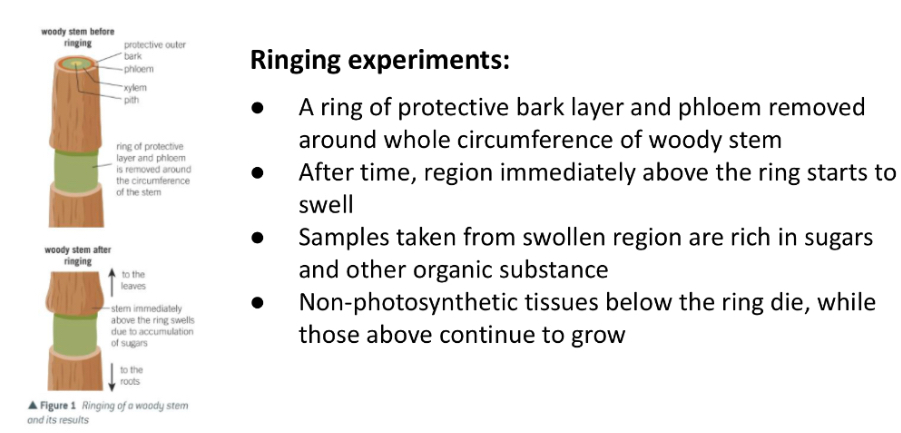Mass transport in plants (phloem)
1/10
Earn XP
Description and Tags
Name | Mastery | Learn | Test | Matching | Spaced |
|---|
No study sessions yet.
11 Terms
What is translocation?
The transport of organic molecules (mainly sugars and amino acids) from the site of production (source) to the place they’ll be used or stored for future use (sink) occurring in the phloem.
What parts of the plant are the source and sink?
Source= leaves
Sink= anywhere in the plant (respiring cells), sometimes above and below the source, so translocation can be either direction.
Describe the structure of a phloem vessel.
Made up of many sieve tube elements- long thin living cells arranged end to end → sieve tube= continuous column
Sieve tube elements have end walls (alive) but are perforated with large pores called sieve plates- allows organic substances to move through them.
Has a companion cell- helps carry out its function.

What are the structure relating to function features of the phloem?
Sieve tube elements- small amount of cytoplasm and few organelles pushed to the sides to allow organic molecules to move through.
Companion cells- active transport is involved in translocation so contain a high number of mitochondria (to make ATP) + ribosomes (to make membrane carrier proteins).
Plasmodesmata- pores that allow movement between companion cells and sieve tube elements.
What are the three stages of mass flow theory?
Transfer sucrose from photosynthesising tissue/cell into sieve tubes (at the source)- called loading.
Mass flow of sucrose through sieve tube down a pressure gradient.
Transfer of sucrose from the sieve tube into sink cells for use or storage- called unloading.
Describe stage 1 of the mass flow theory.
Overall sucrose is actively loaded into the sieve tubes.
Done actively to speed up the process and stop it reaching equilibrium at any point (by diffusion).
Describe stage 2 of the mass flow theory.
The movement of sucrose into the sieve tubes decreases the water potential in the sieve tube at the source.
The water potential in the phloem is lower than in the xylem- water moves into the phloem down its water potential gradient by osmosis.
Xylem have pits in side walls to allow lateral movement of water into phloem.
The increased volume of water creates a high hydrostatic pressure in the sieve tube at the source.
Describe stage 3 of the mass flow theory.
Cells that require sugars will have sucrose actively transported into them from sieve tubes at the sink.
This increases the water potential in the sieve tube at the sink so water will move out by osmosis down its water potential gradient (either back into the xylem or following sucrose into the respiring cells).
This reduced water volume reduces the hydrostatic pressure in the sieve tube at the sink.
Set up a hydrostatic pressure gradient and so there’s mass flow of sucrose solution down its hydrostatic pressure gradient in the sieve tube/phloem from source to sink.
What experimental evidences supports the mass flow theory?
Ringing experiments
Tracer experiments

What do the ringing experiment observations suggest?
Sugars from the phloem are accumulating above the ring- leading to the swelling- so the movement is from source to sink.
Ring has stopped the flow of sugars to region below the ring causing the death of tissues in this region as they can’t respire.
This proves that the phloem transports sugars rather than the xylem because the xylem isn’t damaged but the tissue below still dies.

What do the tracer experiment observations suggest?
As the other tissues don’t blacken, suggests they don’t carry sugars- so just the phloem carries sugars.